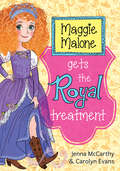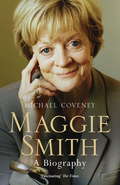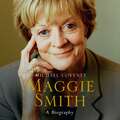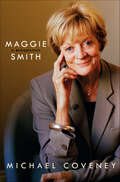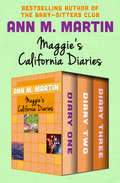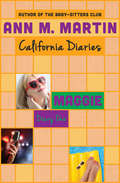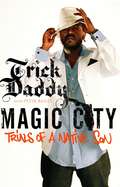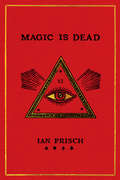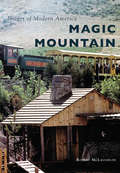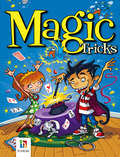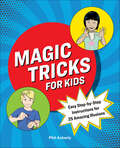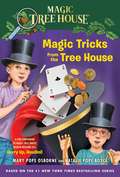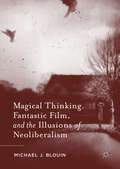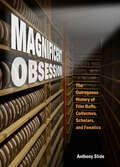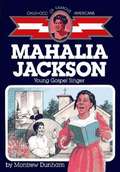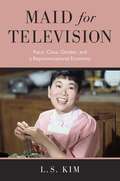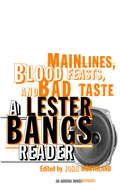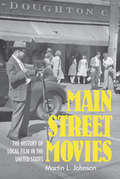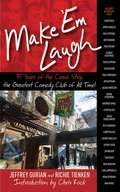- Table View
- List View
Maggie Forevermore
by Joan Lowery NixonHappy living with her Texas grandmother and looking forward to celebrating a family Christmas, thirteen-year-old Maggie is devastated when she is summoned by her movie-director father to spend Christmas with him and her very young stepmother in California.
Maggie Malone Gets the Royal Treatment
by Carolyn Evans Jenna MccarthyWalking a mile in someone else's shoes can be a royal pain Everyday is Freaky Friday for Maggie Malone and her Mostly Magical Boots. Whenever she slips on the MMBs, Maggie gets to be whomever she wants for a whole day. And whose life could be more fun to try on than the glamorous Princess Wilhelmina of Wincastle's? Even better, Wilhelmina is a bridesmaid in the Royal Wedding of the Century! But even pampered princesses have whopper-sized problems-and hers is an evil archenemy named Penelope. Will she survive Penelope's tricks or will the whole wedding turn into a royal disaster?
Maggie Smith: A Biography
by Michael Coveney'Coveney is the only writer who could get under Smith's skin, capturing her steeliness and vulnerability' INDEPENDENT ON SUNDAYFrom her days as a star of West End comedy and revue, Dame Maggie's path has led to international renown and numerous accolades including two Academy Awards. Recently she has been as prominent on our screens as ever, with high-profile roles as the formidable Dowager Countess of Grantham in DOWNTON ABBEY, as Professor Minerva McGonagall in the HARRY POTTER movie franchise and as the eccentric Miss Shepherd in the film version of THE LADY IN THE VAN by Alan Bennett. Paradoxically she remains an enigmatic figure, rarely appearing in public and carefully guarding her considerable talent. Drawing on personal archives, interviews and encounters with the actress, as well as conversations with immediate family and dear friends, Michael Coveney's biography is a captivating portrait of the real Maggie Smith.
Maggie Smith: A Biography
by Michael CoveneyNo one does glamour, severity, girlish charm or tight-lipped witticism better than Dame Maggie Smith, one of Britain's best-loved actors. This new biography shines the stage-lights on the life and career of a truly remarkable performer, one whose stage and screen career spans six decades.From her days as a West End star of comedy and revue, Dame Maggie's path would cross with those of the greatest actors, playwrights and directors of the era. Whether stealing scenes from Richard Burton (by his own admission), answering back to Laurence Olivier, or impressing Ingmar Bergman, her career can be seen as a 'Who's Who' of British theatre in the twentieth century. This book also covers the little-known period in Canada, a prolific five-season run of leading roles that took place during the height of her success in Hollywood, soon after she won her first Oscar for her signature film The Prime of Miss Jean Brodie.Recently Dame Maggie has been prominent on our screens as ever, with high-profile roles as Violet Crawley, the formidable Dowager Countess of Grantham, in the phenomenally successful television series Downton Abbey, and as Professor Minerva McGonagall in the Harry Potter film franchise: what she herself describes as 'Miss Jean Brodie in a wizard's hat'. Yet paradoxically she remains an enigmatic figure, rarely appearing in public and carefully guarding her considerable talent. Michael Coveney's absorbing biography, written with the actress's blessing and drawing on personal archives, as well as interviews with immediate family and close friends, is therefore as close as it gets to seeing the real Maggie Smith.Read by Sian Thomas(p) 2015 Orion Publishing Group
Maggie Smith: A Biography
by Michael Coveney“Steeped in theater history” this biography “seamlessly melds Smith’s personal and professional lives into an engrossing narrative” (Kirkus Reviews).No one does glamour, severity, girlish charm or tight-lipped witticism better than Dame Maggie Smith. Michael Coveney’s biography shines a light on the life and career of a truly remarkable performer, one whose stage and screen career spans six decades.From her days as a West End star of comedy and revue, Dame Maggie’s path would cross with those of the greatest actors, playwrights and directors of the era. Whether stealing scenes from Richard Burton, answering back to Laurence Olivier, or playing opposite Judi Dench in Breath of Life, her career can be seen as a ‘Who’s Who’ of British theatre. Her film and television career has been just as starry. From the title character in The Prime of Miss Jean Brodie and the meddling chaperone in A Room With a View to the Harry Potter films in which she played Minerva McGonagall (as she put it ‘Miss Jean Brodie in a wizard’s hat’) and the Best Exotic Marigold Hotel films in which she played the wise Muriel Donnelly, Smith has thrilled, engaged and made audiences laugh. As Violet Crawley, the formidable Dowager Countess of Downton Abbey she conquered millions more. Paradoxically she remains an enigmatic figure, rarely appearing in public.Michael Coveney’s absorbing biography, written with the actress’s blessing and drawing on personal archives, as well as interviews with immediate family and close friends, is a portrait of one of the greatest actors of our time.
Maggie's California Diaries: Diary One, Diary Two, and Diary Three (California Diaries)
by Ann M. MartinTeenager Maggie Blume struggles with not being perfect in this spin-off from the Newbery Award–winning author&’s Baby-sitters Club series. Straight-A student Maggie might seem perfect, but in reality, her life is anything but. There&’s not much she can do about the demands her dad puts on her, her mother&’s alcoholism, or her insecurity about following her passion for music—but she can control what she eats. As Maggie&’s friends begin to worry that she has an eating disorder, she&’ll have to face the fact that she might have a problem being perfect won&’t solve . . . The next chapter following Ann M. Martin&’s bestselling Baby-sitters Club series, the California Diaries are the first-person journals of Dawn, Sunny, Maggie, Amalia, and Ducky—five teenagers dealing with the ups and downs of growing up. This collection includes the complete set of Maggie&’s three California Diaries.
Maggie: Dawn, Sunny, Maggie, Amalia, And Ducky (California Diaries #3)
by Ann M. MartinMaggie makes everything she does look easy--but there's a high price to pay for perfectionMaggie Blume does everything right. She gets straight A's, is a talented pianist, and was just named the youngest poetry editor of the school's literary magazine, Inner Vistas. She makes the life of a successful thirteen-year-old look easy.For Maggie's father, nothing but perfect will do. Not only is he obsessed with his job as a studio executive, he expects Maggie to have a detailed plan for her life, which unfortunately leaves no room for her true passion: music.Once Maggie's friends learn of her talent, they help her land a spot as the lead singer for Vanish, the band managed by her friend Amalia. Maggie could never share this news with her dad, so when she has to choose between going to his movie opening and the battle of the bands, she takes a huge risk to make sure she's able to do it all--perfectly.This ebook features an illustrated personal history of Ann M. Martin, including rare images from the author's collection.
Magic City: Trials of a Native Son
by Peter Bailey Trick Daddy"A thug is someone who stands on his own. He lives by the decisions he makes and accepts the consequences. A thug is comfortable in his own skin. I wear mine like a glove." Trick Daddy was born a thug--just a stone's throw from downtown Miami, yet a world away from its dazzling beauty and sparkling wealth. Where grinding poverty, deadly crime, and devastating racial tension taught kids to live by the 'hood rules. Remarkably, Trick came from nothing and made it big just when his chances had run out. Magic City is the extraordinary tale of a boy whose father was a pimp, who learned to hustle to survive, and whose only role model was his brother, the drug dealer he watched plying his trade on the block. It's the untold truth behind the cult movie Scarface, of the drug money that transformed the city into a shining mecca for the rich and famous while turf wars between smalltime pushers claimed countless lives. It's also the incredible story of how that potent mixture of extremes--the electric pulse and glittering abundance of South Beach and the crime, corruption, and despair in its shadows--gave rise to the most dominant sound in hip-hop today. Magic City is an ode to Miami, a riveting tale of a paradise lost and a native son determined to infuse it with new life.
Magic Is Dead: My Journey into the World's Most Secretive Society of Magicians
by Ian FrischA journalist recounts his life-changing journey through the secret world of underground magic in this “funny, illuminating, and personal” memoir (Brooklyn Rail)When struggling journalist Ian Frisch came across magician Chris Ramsey on Instagram, he knew he had the makings of a good story. But what began as a simple profile piece led Ian to the52—a secret society of magicians determined to revolutionize their ancient artform under the mantra Magic Is Dead.As Ian gains entry to the52, he forms close bonds with its founding members—Laura London, Daniel Madison, and Chris Ramsay. He attends private gatherings of the most extraordinary magicians working today, follows them to magic conventions in Las Vegas and England, and discovers some of the best tricks of the trade. He also goes behind the scenes of a Netflix magic show and encounters David Blaine, Penn Jillette, and Dynamo, the U.K.’s most famous magician.As Ian tells the story of the52, and his role as its most unlikely member, he reveals his own connection with trickery and deceit, sharing how he first learned the elements of magic from his poker-playing mother. Rich with the history of magic and populated with a cast of fascinating characters, Magic Is Dead is a page-turning work of immersive journalism coupled with a young man searching for himself.
Magic Mountain (Images of Modern America)
by Robert MclaughlinNestled in the foothills of Golden, Colorado, construction started on Magic Mountain just two years after Disneyland's opening season. Through never-before-seen photographs, Magic Mountain tells the exciting story of the first attempt in America to spread the Disneyland model. The dream of a theme park in Colorado was conceived by Walter F. Cobb and designed by Marco Engineering of Los Angeles. The park saw tens of thousands of visitors, even during the construction period. They witnessed live gunfights and playhouse melodramas and took a ride on the Magic Mountain Railroad. Unfortunately, the park closed at the end of its premier season in 1960, but it would eventually evolve into Heritage Square. For over 40 years, this venue brought fun and entertainment to the young and young at heart, following Cobb's vision of a clean, entertaining, and educational park for the whole family.
Magic Tricks
by Hinkler BooksEntertain your family and friends for hours with these awesome magic tricks! With comical illustrations by Glen Singleton, Magic Tricks covers everything from card and coin tricks to disappearing acts. Put on a show or amuse yourself with the amazing world of magic.
Magic Tricks for Kids: Easy Step-by-Step Instructions for 25 Amazing Illusions
by Phil AckerlyLearn magic and performance skills with 25 astounding magic tricks!Want to learn how to levitate a coffee cup? Magically double your money? Become a mind reader? Discover the secrets to these tricks and more in Magic Tricks for Kids. Watch jaws drop as you perform these wonderful illusions using simple, step-by-step instructions and homemade props.Gain confidence with easier tricks at the start of the book before moving on to more complex magic tricks that require sleight-of-hand skills. Finally, learn some spellbinding card tricks and how to make items appear out of thin air! You'll wow your family and friends while learning the art of a mesmerizing performance.Magic Tricks for Kids includes:DIY magic—All the magic tricks use simple household objects, making them easy to perform anytime. A chapter on magical crafts also shows you how to make a magic wand, a magic box, and a magic table to help you put on fantastic shows at home.The code—Learn the respected "Magician's Code," including the most important rule—never reveal how the trick is done.More than magic—With sample scripts to go along with each trick, you'll learn the art of patter—injecting your performance with comedy, suspense, and surprise!With Magic Tricks for Kids, you'll blow minds and astonish your friends.
Magic Tricks from the Tree House
by Mary Pope Osborne Sal Murdocca Natalie Pope Boyce Luiz VilelaIt's a book of magic tricks perfect for chapter book readers! When Jack and Annie went back in time to meet Houdini, they learned that the most famous magician of all time didn't use real magic at all. It was a trick! Now they've tracked down all the best, most fun, most tricky magic tricks and put them together in one book. With simple instructions, easy-to-follow diagrams, and tips from Jack and Annie, Magic Tricks from the Tree House is tailor-made to teach kids how to wow friends and family in their very own magic shows. Includes facts about famous magicians and famous tricks.
Magical Movie Handbook (Fantastic Beasts and Where to Find Them)
by Michael KoggeHighlights all your favorite characters, locations, and magical moments featured in the film!The experience of this eBook will be best if viewed on a tablet.
Magical Thinking, Fantastic Film, and the Illusions of Neoliberalism
by Michael J. BlouinConsidering films such as Candyman, Frozen, and The Cabin in the Woods, Michael J. Blouin contends that fantastic tales allow audiences to maintain the status quo instead of inspiring purposeful action.
Magnificent Obsession: The Outrageous History of Film Buffs, Collectors, Scholars, and Fanatics
by Anthony SlideIn Magnificent Obsession: The Outrageous History of Film Buffs, Collectors, Scholars, and Fanatics, author Anthony Slide looks at the way film has dominated the minds and lives of film buffs, film collectors, film academics, and just plain fans of past movies. Based on the author's more than fifty years in the field and his personal, up-front knowledge of the subject, chapters provide unique documentation on film buffs who once created a livelihood from their hobby, including long-forgotten Chaw Mank and the vast array of film clubs that he headed and New York radio and television sensation Joe Franklin. The history of fans and their fan clubs are discussed, as well as the first and only periodical, Films in Review, which catered both to film scholars and film buffs. The histories of several legendary film collectors such as David Bradley and Herb Graff are featured, as is Hollywood's Silent Movie Theatre, where film buffs found a home from the 1940s onwards, sharing it with drug dealers, male prostitutes, fantasists, and hit men.Magnificent Obsession is vast in its approach, discussing the entire history of the phenomenon of the film buff from the early 1910s through the present and documenting the manner in which film buffs have changed--thanks to the internet--from relatively gentle and kind individuals to the obsessive, sometimes overbearing, and often self-important film buffs of today.
Magnolia (Wiley-blackwell Series In Film And Television Ser. #15)
by Christina LaneThere are certain films and shows that resonate with audiences everywhere—they generate discussion and debate about everything from gender, class, citizenship and race, to consumerism and social identity. This new 'teachable canon' of film and television introduces students to alternative classics that range from silent film to CSI. Magnolia is one of those films students know and love. From the over-the-top performances by male and female leads to the "ripped from the pages of the Old Testament" conclusion, it is a cult favorite in American cinema This is the first book to examine the diverse themes, performances, and influences on this polarizing film, encouraging students to look beyond the film's style in order to fully engage with questions about its substance Lane develops a careful analysis of the film, its director, as well as the contemporary context in which it was produced - exploring topics including the role of the auteur, what constitutes cinema / media literacy in the digital age, the politics of postmodernism, and the film's critique of the mass media - in order to challenge students to ask themselves why they are so riveted by this controversial and unusual film
Mahalia Jackson: Young Gospel Singer (Childhood of Famous Americans Series)
by Montrew DunhamBiography of the great gospel singer, Mahalia Jackson.
Maid for Television: Race, Class, Gender, and a Representational Economy
by L. S. KimMaid for Television examines race, class, and gender relations as embodied in a long history of television servants from 1950 to the turn of the millennium. Although they reside at the visual peripheries, these figures are integral to the idealized American family. Author L. S. Kim redirects viewers' gaze towards the usually overlooked interface between characters, which is drawn through race, class, and gender positioning. Maid for Television tells the stories of servants and the families they work for, in so doing it investigates how Americans have dealt with difference through television as a medium and a mediator.The book philosophically redirects the gaze of television and its projection of racial discourse.
Main Lines, Blood Feasts, and Bad Taste: A Lester Bangs Reader
by John MorthlandBefore his untimely death in 1982, Lester Bangs was arguably the most influential critic of rock and roll. Writing in hyper-intelligent Benzedrine prose that calls to mind Jack Kerouac and Hunter S. Thompson, he eschewed all conventional thinking as he discussed everything from Black Sabbath being the first truly Catholic band to Anne Murray's smoldering sexuality. In Mainlines, Blood Feasts, Bad Taste fellow rock critic John Morthland has compiled a companion volume to Psychotic Reactions and Carburetor Dung, the first, now classic collection of Bangs's work. Here are excerpts from an autobiographical piece Bangs wrote as a teenager, travel essays, and, of course, the music pieces, essays, and criticism covering everything from titans like Miles Davis, Lou Reed, and the Rolling Stones to esoteric musicians like Brian Eno and Captain Beefheart. Singularly entertaining, this book is an absolute must for anyone interested in the history of rock.
Main Street Movies: The History of Local Film in the United States
by Martin L. Johnson"See yourself in the movies!"Prior to the advent of the home movie camera and the ubiquitousness of the camera phone, there was the local film. This cultural phenomenon, produced across the country from the 1890s to the 1950s, gave ordinary people a chance to be on the silver screen without leaving their hometowns. Through these movies, residents could see themselves in the same theaters where they saw major Hollywood motion pictures. Traveling filmmakers plied their trade in small towns and cities, where these films were received by locals as being part of the larger cinema experience. With access to the rare film clips under discussion, Main Street Movies documents the diversity and longevity of local film production and examines how itinerant filmmakers responded to industry changes to keep sponsors and audiences satisfied. From town pride films in the 1910s to Hollywood knockoffs in the 1930s, local films captured not just images of local people and places but also ideas about the function and meaning of cinema that continue to resonate today.
Mainstreaming Palestine: Cinematic Activism and Solidarity Politics in the United States
by Umayyah CableA history of cinema&’s role in popularizing the politics of Palestinian liberation For decades, Arab American activists and allies have used film, video, and multimedia to mobilize support for the Palestinian cause in the United States. In this detailed history of cinema&’s role within the broader solidarity movement, Umayyah Cable analyzes the various strands of cinematic activism that have helped move Palestinian liberation politics from the periphery and into the mainstream. Cable charts the shifting discourse around Palestine as it has been shaped by grassroots film production and alternative media distribution networks as well as more conventional outlets. Ranging from the circulation of educational filmstrips by the Association of Arab American University Graduates in the 1970s to the treatment of Palestinian solidarity at contemporary Hollywood awards ceremonies and film festivals, Mainstreaming Palestine tells the story of how cinema has promoted Palestinian liberation and solidarity politics. While highlighting various public controversies and struggles against censorship, Cable also acknowledges the drawbacks of the Palestinian cause being subsumed by the mainstream, discussing how activism risks becoming fashionable, undermining the radical potential of the very tools that helped bring it there. Combining archival research, ethnographic observation and interviews, text analysis, and visual analysis of film, video, and multimedia, Mainstreaming Palestine encourages readers to critically assess the relationship between the politics of liberation and the all-consuming engine of contemporary capitalism. By underscoring the impact of visual media on the evolution of the Palestinian solidarity discourse, this book offers both a treatise on the practical power of cinema and a necessary historicization of an urgent issue in American politics. Retail e-book files for this title are screen-reader friendly with images accompanied by short alt text and/or extended descriptions.
Mais verdade, mentiras e propaganda
by Lucinda E ClarkeMais histórias inacreditáveis pelas lentes de Lucinda e sua "Equipe Arco-Íris" em suas viagens através da África do Sul. Eles conhecem Mandela, passam por momentos de terror e socializam com tribos de bosquímanos praticamente lançados à própria sorte. Encontram-se em meio a tumultos urbanos, veem uma paciente abandonada, sofrem uma crise de identidade, e então uma casa desaparece. Essas histórias, ao mesmo tempo hilárias e de cortar o coração, revelam a verdade sobre o que acontece nos bastidores das cenas que a mídia exibe. Este livro prova que a propaganda segue viva e bem, nas telinhas da televisão no mundo inteiro.
Majestic Hollywood: The Greatest Films of 1939
by Mark A. Vieira1939 was a watershed year. The Great Depression was barely over; economics, politics, and culture braced for war. There was a lull before the storm and Hollywood, as if expecting to be judged by posterity, produced a portfolio of classics. No year before or since has yielded so many beloved works of cinematic art: The Hunch-back of Notre Dame, Gunga Din, Only Angels Have Wings, Destry Rides Again, Beau Geste, Wuthering Heights, The Wizard of Oz, Stagecoach, Ninotchka, Goodbye, Mr. Chips, Dark Victory, Mr. Smith Goes to Washington, The Women, and of course, Gone With the Wind. 1939: Hollywood’s Greatest Year showcases fifty films from this landmark year, with insightful text on the cultural significance of each movie and entertaining plot descriptions. Also included are stories from the legendary artists who made the films: directors William Wellman and John Ford; cinematographers Arthur Miller and Lee Garmes; actors Judy Garland, Rosalind Russell, Ray Milland, Sir Laurence Olivier, and Olivia de Havilland. This world of entertainment is illustrated by rarely seen images. Made during the most glamorous era in movie history, whether scene stills, behind-the-scenes candids, portraits, or poster art, the photos are as distinctive, evocative, and powerful as the films they were meant to publicize. Presenting the best of these images and the stories behind them, this book is a cavalcade of unforgettable films from 1939: Hollywood’s Greatest Year.
Make 'Em Laugh: 35 Years of the Comic Strip, the Greatest Comedy Club of All Time!
by Chris Rock Jeffrey Gurian Richie TienkenThis behind-the-scenes history of the legendary New York City club includes interviews with many top standup comedians. The Comic Strip on New York’s Second Avenue is a historic landmark as a comedy showcase, and generations of standup comedians have cherished it as a venue that fosters growth and camaraderie, experimentation and freedom. This is an inside look at how it all happened, straight from the mouths of the stars who built their careers on its stage. Owner Richie Tienken and a wealth of comics open their hearts and souls to share their most intimate memories, the laughs and tears, the good times and the bad, painting a lively picture of this iconic club. With an introduction by Chris Rock, Make ’Em Laugh also includes reminiscences from: • Jerry Seinfeld • Gilbert Gottfried • Paul Reiser • Lisa Lampanelli • George Wallace • Billy Crystal • Jim Breuer • Susie Essman • Lewis Black • Ray Romano • Jim Gaffigan • Judah Friedlander • Colin Quinn • and many more

